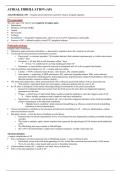ATRIAL FIBRILLATION (AF)
Atrial fibrillation (AF) = irregular atrial contraction caused by chaotic irregular impulses.
-----------------------------------------------------------------------------------------------------------------------------------------------------
Presentation
The only sign of AF may be an irregularly irregular pulse.
§ Palpitations
§ Shortness of breath (SOB)
§ Angina
§ Pre-syncope
§ Lethargy
§ Examination ® irregularly irregular pulse, absent a wave on JVP, hypotension, tachycardia
§ Features of HF ® bibasal crackles, raised JVP, peripheral oedema
-----------------------------------------------------------------------------------------------------------------------------------------------------
Pathophysiology
Irregular atrial contraction.
§ Defined as supraventricular arrhythmia ® abnormality originates above the ventricles in the atria
§ Can be paroxysmal, persistent or permanent in nature
o Paroxysmal ® recurrent episodes (>30 seconds duration) that terminate spontaneously or within intervention
within 7 days
o Persistent ® AF that fails to self-terminate within 7 days
§ If lasts >12 months known as long standing persistent AF
o Permanent ® sinus rhythm cannot be restored or maintained and AF is the accepted final rhythm
§ Lots of conditions can predispose to AF ® cardiac and non-cardiac
o Cardiac ® HTN, ischaemic heart disease, valve disease, MI, cardiomyopathy
o Non-cardiac ® respiratory (COPD, pneumonia, PE), endocrine (hyperthyroidism, DM), acute infection,
electrolyte disturbance (hypokalaemia, hypomagnesaemia, hyponatraemia), drugs (bronchodilators, thyroxine),
lifestyle (alcohol, excessive caffeine, obesity)
§ The atrial myocardium has a short action potential with a refractory period that reduces with an increasing rate
o This permits a rapid atrial heart rate and complex conduction patterns that are seen in AF
§ In AF, there is disruption of the normal electrophysiological mechanisms in the atrial myocardium
o Instead of coordinated electrical activity from the SAN across the atria, there are fragmented impulses
generated over the atria
o Trigger ® initial focus of rapid atrial firing, usually around the pulmonary veins that triggers onset of AF
§ Others include: premature atrial complexes and other arrhythmias
o Maintenance ® in patients with persistent AF, once it has been triggered, alteration in the atrial myocardium
enables maintenance of the abnormal arrhythmia
§ Multiple factors contribute: atrial structural remodelling (e.g. fibrosis), atrial electrical remodelling
(alteration to atrial refractoriness)
§ Various mechanisms contribute to the structural and electrical remodelling in AF ® fibrosis, inflammation, oxidate
stress and reentrant circuits
§ Reentrant circuits ® form the basis of multiple wavelet theory
o Proposes that wavefronts (spontaneous waves of excitation) become fragmented resulting in multiple daughter
wavelets
o This leads to multiple, rapid, chaotic impulses that supersede the physiological SAN rhythm and bombard the
AVN
o The fibrillating atria may contract at 300-600 bpm
o The AVN will intermittently conduct these impulses leading to variable ventricular rate.
Thromboembolism
® major complication of AF
§ Poor coordination of atrial contraction due to fibrillating muscle ® stasis of blood in atria
o Particularly occurs in the left atrial appendage (LAA), a finer like extension from main body of left atrium
o The LAA acts like a static pouch and is prone to thrombus formation
§ If this thrombus breaks off ® embolus, can block artery at distal site
§ This is why anticoagulation is used in AF.




